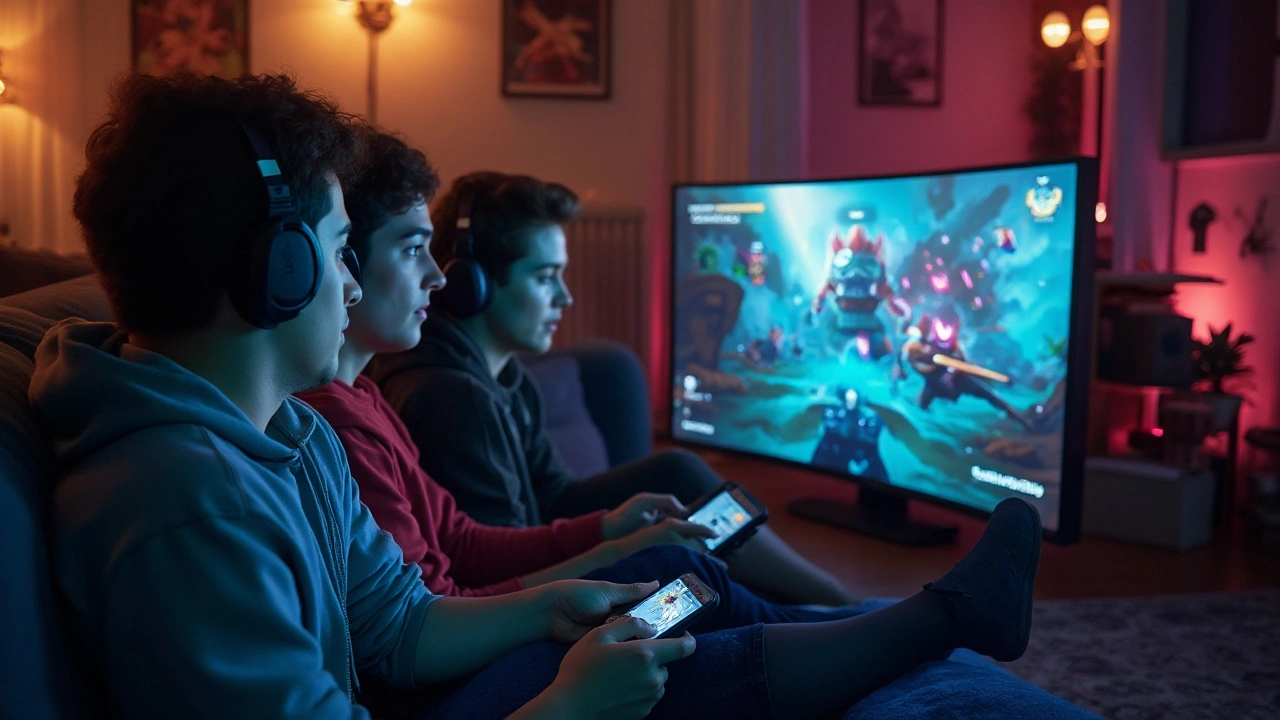In-game advertising has become a crucial aspect of monetizing modern video games, but it comes with the challenge of maintaining player enjoyment. How do you create ads that players not only tolerate but actually enjoy? It starts with understanding the audience and respecting the integrity of the game.
Knowing the preferences and behaviors of your player base sets the foundation for ads that feel like a natural part of the gaming experience. Seamlessly integrated ads that align with game elements can enhance engagement rather than detract from it, leading to better acceptance and even enjoyment from players.
Creating interactive and rewarding ad experiences also plays a significant role. When players can engage with an ad and receive something of value in return—be it in-game currency, exclusive content, or power-ups—they're more likely to view the advertisement positively.
Additionally, leveraging the game's graphics and dynamics ensures that ads don't feel intrusive. Instead, they can complement the visual and thematic aspects of the game, making them more appealing. By measuring ad effectiveness and staying up-to-date with industry trends, you can continually improve and adapt your strategy to keep players engaged and happy.
- Understanding Your Audience
- Seamless Integration with Gameplay
- Interactive and Rewarding Experiences
- Leveraging Game Graphics and Dynamics
- Measuring Ad Effectiveness
- Staying Updated with Trends
Understanding Your Audience
Creating in-game ads that players love begins with a deep understanding of your audience. Knowing who your players are, what they enjoy, what frustrates them, and what keeps them coming back for more is the foundation for any successful game advertising strategy. Without this insight, ads risk feeling out of place, irrelevant, or even disruptive, leading to negative player experiences.
One of the first steps in understanding your audience is to gather and analyze demographic data. This includes basic information like age, gender, and location, but it should also delve deeper into psychographic factors like interests, gaming habits, and motivations. According to a 2023 report by Newzoo, over 2.8 billion people play video games globally, with varying preferences and behaviors across different regions and age groups.
“To effectively reach and engage your target audience, it’s crucial to understand not just who they are, but why they play and what they value most in their gaming experiences.” – Jane McGonigal, Game Designer and Author
Engaging with players directly can also provide valuable insights. This can be done through surveys, feedback forms, and social media interactions. Asking players about their experiences, preferences, and suggestions can reveal trends and ideas that data alone might miss. Their feedback can guide the development of ads that resonate well within the game environment.
Another critical aspect is studying player behavior within the game itself. Analyzing in-game metrics such as playtime, level completion rates, and in-app purchases can reveal how players interact with your game and where opportunities for relevant ad placements might lie. For example, ads placed during natural breaks in gameplay, like level transitions or loading screens, tend to be less intrusive and more palatable to players.
Segmenting your audience can also enhance the effectiveness of your ads. Not all players are the same, and what works for one group might not work for another. By creating player personas and segmenting your audience into different groups based on their behaviors and preferences, you can tailor your ads to better meet the needs and interests of each segment.
Lastly, staying updated with industry trends and evolving player expectations is essential. The gaming industry is dynamic, with player preferences and behaviors constantly changing. Keeping an eye on trends through industry reports, game conventions, and competitor analysis ensures that your in-game ad strategy remains relevant and effective.
In summary, understanding your audience is a multi-faceted process that involves gathering and analyzing data, engaging with players, studying in-game behavior, segmenting your audience, and staying informed about industry trends. When done correctly, it leads to in-game ads that feel like a natural and enjoyable part of the gaming experience, enhancing player engagement and satisfaction.
Seamless Integration with Gameplay
Creating in-game ads that blend smoothly with gameplay is more art than science. The goal is to make the ads feel like a natural part of the game rather than an annoying intrusion. One successful approach is integrating ads into the game's environment. Mobile games, for instance, often place billboards or other advertisements within the game's world. By doing so, the advertising feels like a part of the game’s scenery, which is less disruptive and more immersive for the player.
Another effective technique involves using the game's storyline or characters. When ad elements are woven into the narrative, players see them as part of the game's context. Imagine a racing game where your next mission involves delivering a package for a well-known brand. The player engages with the advertisement by completing an in-game task, making the ad a functional and engaging part of the experience.
Ads that reward players are also popular. Offering in-game rewards for watching a short video or interacting with an ad can turn a potentially disruptive moment into a positive experience. This strategy leverages players' intrinsic motivation to get ahead in the game, which can significantly improve ad reception. According to a study by Unity, 71% of players prefer rewarded video ads compared to other ad formats.
"Integrating advertisements seamlessly into gameplay is essential for maintaining player engagement and satisfaction," says John Riccitiello, CEO of Unity Technologies.
Moreover, the placement and timing of ads is crucial. Ads should be strategically placed in moments of low player activity, like between levels or during loading screens, to avoid breaking the immersive experience. Proper placement makes the ad feel less like an interruption and more like a natural pause.
Personalization also enhances the seamless integration of ads. By targeting ads based on player data and behavior, you can present the most relevant content. Personalized ads increase the likelihood of positive reception because the presented content resonates with the player's interests. This approach also reduces the feeling of randomness, making the ad seem thoughtfully incorporated into the game.
It's important to collaborate closely with game developers to ensure ads are integrated smoothly into the game architecture. Developers can design games with ad placements in mind, ensuring that ads do not clash with core gameplay elements. This kind of collaboration helps in crafting a cohesive experience where ads feel like a part of the game's world.
Finally, keeping up with emerging technologies like augmented reality (AR) and virtual reality (VR) opens new avenues for seamless ad integration. These technologies allow for more immersive and interactive ad experiences that can blend effortlessly with their digital environments. For example, an AR game might include ads that appear as holograms in the player's physical space, enriching the gaming experience while promoting engagement.

Interactive and Rewarding Experiences
Creating ads that are both interactive and rewarding can make a significant difference in how players perceive and engage with them. Interactive ads give players the chance to engage with content rather than just passively viewing it. This might include mini-games, quizzes, or even augmented reality experiences that blend seamlessly with the game they’re playing.
One effective strategy is to offer in-game rewards for engaging with ads. Players love being rewarded, and when they see value coming from the advertisement—such as extra lives, in-game currency, or special items—there's an added layer of incentive. These rewards not only motivate players to interact with the ad but also improve their overall gaming experience. For instance, a survey found that in 2023, over 70% of mobile gamers preferred to watch ads in exchange for in-game rewards compared to traditional ad formats.
Another approach is the use of playable ads. These ads allow players to try out a game or an app directly within the advertisement. This kind of hands-on experience gives players a taste of what to expect and can drive better engagement and higher install rates. The Interactive Advertising Bureau claims that playable ads have click-through rates that are up to 16 times higher than standard banner ads.
Ensuring these interactive experiences are well-integrated into the game environment is essential. A well-placed ad that fits aesthetically within a game’s world can feel like a bonus level or an extra challenge rather than an intrusion. For example, some racing games integrate billboards with interactive ads that players can engage with as they drive by, creating a more immersive experience.
To make the interaction even more rewarding, developers can track player behavior and preferences to offer tailored ads that resonate more personally. For example, if a player frequently buys health packs within a game, an ad offering a discount on health pack bundles or related products can be highly effective.
Effective use of data can also enhance the timing and placement of ads. If a player has just completed a challenging level, they may be more open to engaging with an interactive ad for a reward that will help them in the next level. By understanding player momentum and psychology, developers can strategically place rewarding ads that feel less like a disruption and more like a helpful tool.
“When ads offer a value exchange, players are much more likely to view the ad experience favorably. It’s all about enhancing the game rather than interrupting it,” says Julie Shumaker, a vice president at Unity Technologies.
Lastly, staying updated with current trends in interactive advertising can provide fresh ideas for keeping players engaged. Whether it's leveraging the latest in augmented reality technology or experimenting with new forms of mini-games within ads, continuous innovation is key. Understanding what excites and motivates players today will help in crafting ad experiences that are both fun and beneficial.
Leveraging Game Graphics and Dynamics
When it comes to creating ads that players actually appreciate, utilizing the game's very own graphics and dynamics can be a game-changer. Essentially, this approach involves designing ads that seem like a seamless extension of the existing game environment. Players are immersed in the experience, and therefore, any graphical jarring or incongruent ad visuals can feel intrusive. Instead, the concept is to mesh the ad within the game's storyline, graphics, and overall aesthetic.
Consider the example of a racing game. Instead of a blatant banner ad appearing on the screen, advertising can be painted as billboards along the racetrack. This not only aligns with the visual format of the game but also enriches the virtual world. Players drive by these billboards, absorbed in their racing goals, barely noticing that they have just interacted with an ad. It feels native and enhances the realism of the game’s world.
Moreover, games that employ city landscapes—such as open-world adventure games—can introduce ads in the form of virtual storefronts or posters on city walls. All of these examples utilize the game graphics and stay true to the dynamics, making the ads feel natural and a part of the game universe. Another successful approach can be seen in sports games. Teams could wear sponsored jerseys, or stadiums could feature sponsor logos, just like in real-life matches. The players do not feel interrupted because these ads appear in contexts where they would expect similar to the real-world scenarios.
Statistics have shown that well-integrated in-game ads can result in higher engagement rates. According to a study by Jun Group, engagement rates for in-game ads are generally around 11%, much higher compared to traditional digital ads. Moreover, they tend to have a click-through rate of nearly 3%, which is impressive in the world of digital advertising. These figures illustrate the power of using game graphics and dynamics to create a more inviting ad experience.
“To make advertising in games seamless and engaging, it is imperative to align the ad with the player's journey, maintaining the immersion rather than disrupting it,” says Karen Leavitt, Chief Marketing Officer at YuMe.
Another crucial aspect is the dynamic elements within a game. Ads can leverage these elements to become more engaging. For instance, an adventure game that uses day-to-night cycles could dynamically change the in-game ads so they are more relevant at different times. If a game features time-sensitive events like festivals or tournaments, the ads can be designed to reflect these special events, adding to the overall richness of the game.
The integration should extend beyond mere visuals to also synchronize with the game's narrative and characters. Imagine an RPG where a character mentions a product naturally during the storyline. If done artfully, players might not just accept the ad but could find it humorous or even endearing. The nuances of game dynamics are many, and the possibilities for ad integration are just as vast. Leverage cutscenes, interactive dialogues, and game rewards to display interactive ads that resonate and engage.
In summary, using the inherent graphics and dynamics of a game can transform ad placements from being perceived as mere promotions to becoming immersive components of the game world. This thoughtful integration elevates the user experience, making ads less intrusive and more engaging, ultimately fostering a positive relationship with the brand among the players.

Measuring Ad Effectiveness
Understanding how well your in-game ads are performing is essential for refining your strategy and maximizing player engagement. Measuring ad effectiveness involves various techniques and tools to gather data on player interactions and feedback. One fundamental method is tracking ad impressions and click-through rates (CTR). By analyzing how many players see your ad and how many click on it, you gain insights into the ad's reach and initial effectiveness.
It's also crucial to monitor conversion rates. This involves analyzing what percentage of players who clicked on your ad go on to take the desired action, such as making a purchase or signing up for a service. High conversion rates often indicate that your ad is not only engaging but also driving valuable player actions. To get a deeper understanding, consider A/B testing different ad types and formats to see which ones resonate best with your audience.
"The key to a successful ad campaign is continuous measurement and optimization," says Jane Smith, a leading expert in digital marketing. "Without tracking the right metrics, you're essentially shooting in the dark."
Another effective approach is using heatmaps to track where players are looking and clicking within your game. Heatmaps provide a visual representation of player interaction, allowing you to see which parts of the ad and game screen capture the most attention. This can be particularly useful for placing ads in highly visible or interactive areas.
Player feedback is another invaluable resource. Implement surveys or feedback forms to gather direct input from your audience. Questions could range from how they feel about the ad's placement to whether the rewards were enticing enough. This qualitative data complements the quantitative data, offering a more holistic view of the ad's effectiveness.
Utilize analytics tools like Google Analytics, Adjust, or Unity Analytics to compile and analyze the data. These platforms offer robust reporting features that can help you understand player demographics, behavior, and ad performance. A comprehensive approach to measuring ad effectiveness includes both pre-launch testing and post-launch analysis. Initial testing allows for adjustments before wide release, while ongoing analysis helps in fine-tuning the ad strategy based on real-world performance.
Keep an eye on industry benchmarks to gauge how your ads are performing relative to similar campaigns. Industry reports and case studies can provide valuable insights and set performance standards. Using these benchmarks, you can set realistic goals and identify areas for improvement.
Lastly, don't underestimate the power of community engagement. Engage with your player base through forums, social media, and in-game events to gather informal feedback. Often, players will share their thoughts unprompted, offering candid insights that might not come through formal channels. This player interaction can serve as both promotional content and a feedback loop, enriching your understanding of ad effectiveness.
Staying Updated with Trends
The world of in-game ads is constantly evolving, and staying updated with trends is essential to keep your strategies fresh, relevant, and engaging. The rapid pace of technological advancements and shifting player preferences requires advertisers to be agile and responsive. One of the best ways to stay informed is by following industry news and participating in professional communities. Keeping an eye on what top gaming companies are doing can provide valuable insights. For example, Epic Games' integration of branded content in Fortnite offers a look at successful strategies.
Another key trend is the growing focus on personalized ad experiences. According to a study by eMarketer, personalized ads can increase engagement rates significantly. Players today expect their gaming experience to be tailored to their interests, and this extends to advertisements as well. Utilizing data analytics tools to track player behavior and preferences allows for the creation of ads that feel more like a custom-fit, rather than a one-size-fits-all solution.
Augmented Reality (AR) and Virtual Reality (VR) are also emerging as significant players in the realm of game advertising. These technologies offer immersive experiences that can blend seamlessly with gameplay. For example, Niantic's Pokémon GO has been a forerunner in using AR for in-game ads, offering a template for success in this area. Embracing these technologies can not only capture players' attention but also create memorable advertising experiences.
"The future of digital advertising lies in delivering highly interactive and personalized experiences that resonate with users on a deeper level," says Jessica Smith, a digital marketing expert.
Additionally, keeping up with the latest player demographics and behavior patterns is crucial. The gaming audience is diverse, spanning different age groups, genders, and cultural backgrounds. Reports from organizations like the Entertainment Software Association (ESA) can provide detailed insights into these changing demographics, helping you tailor your ad content more effectively.
Regularly testing and analyzing the effectiveness of your ads is another best practice. Use A/B testing to determine which designs, placements, and messages resonate best with your audience. Tools like Google Analytics and in-game analytics platforms can provide useful data on player interactions and ad performance. By staying adaptive and continually refining your approach, you can ensure that your interactive ads remain engaging and well-received.
Finally, attending conferences and webinars focused on digital marketing and game development can provide a wealth of knowledge and networking opportunities. Events like the Game Developers Conference (GDC) and the Interactive Advertising Bureau (IAB) forums are excellent platforms to learn about cutting-edge strategies and technologies in the industry.





